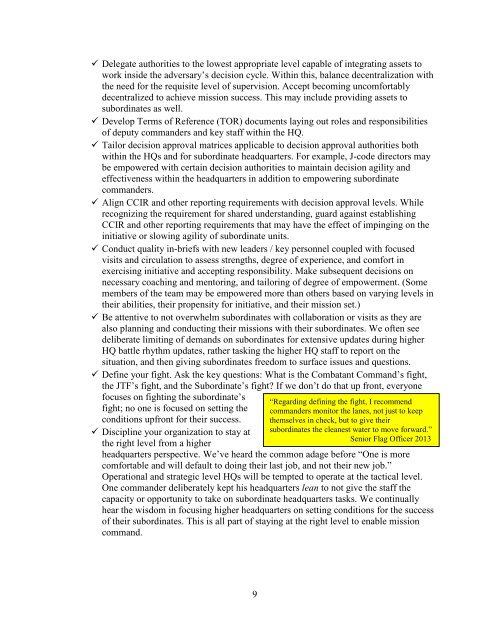Mission Command and Cross-Domain Synergy - Defense ...
Mission Command and Cross-Domain Synergy - Defense ...
Mission Command and Cross-Domain Synergy - Defense ...
- No tags were found...
Create successful ePaper yourself
Turn your PDF publications into a flip-book with our unique Google optimized e-Paper software.
Delegate authorities to the lowest appropriate level capable of integrating assets towork inside the adversary’s decision cycle. Within this, balance decentralization withthe need for the requisite level of supervision. Accept becoming uncomfortablydecentralized to achieve mission success. This may include providing assets tosubordinates as well. Develop Terms of Reference (TOR) documents laying out roles <strong>and</strong> responsibilitiesof deputy comm<strong>and</strong>ers <strong>and</strong> key staff within the HQ. Tailor decision approval matrices applicable to decision approval authorities bothwithin the HQs <strong>and</strong> for subordinate headquarters. For example, J-code directors maybe empowered with certain decision authorities to maintain decision agility <strong>and</strong>effectiveness within the headquarters in addition to empowering subordinatecomm<strong>and</strong>ers. Align CCIR <strong>and</strong> other reporting requirements with decision approval levels. Whilerecognizing the requirement for shared underst<strong>and</strong>ing, guard against establishingCCIR <strong>and</strong> other reporting requirements that may have the effect of impinging on theinitiative or slowing agility of subordinate units. Conduct quality in-briefs with new leaders / key personnel coupled with focusedvisits <strong>and</strong> circulation to assess strengths, degree of experience, <strong>and</strong> comfort inexercising initiative <strong>and</strong> accepting responsibility. Make subsequent decisions onnecessary coaching <strong>and</strong> mentoring, <strong>and</strong> tailoring of degree of empowerment. (Somemembers of the team may be empowered more than others based on varying levels intheir abilities, their propensity for initiative, <strong>and</strong> their mission set.) Be attentive to not overwhelm subordinates with collaboration or visits as they arealso planning <strong>and</strong> conducting their missions with their subordinates. We often seedeliberate limiting of dem<strong>and</strong>s on subordinates for extensive updates during higherHQ battle rhythm updates, rather tasking the higher HQ staff to report on thesituation, <strong>and</strong> then giving subordinates freedom to surface issues <strong>and</strong> questions. Define your fight. Ask the key questions: What is the Combatant <strong>Comm<strong>and</strong></strong>’s fight,the JTF’s fight, <strong>and</strong> the Subordinate’s fight? If we don’t do that up front, everyonefocuses on fighting the subordinate’sfight; no one is focused on setting theconditions upfront for their success. Discipline your organization to stay atthe right level from a higher“Regarding defining the fight, I recommendcomm<strong>and</strong>ers monitor the lanes, not just to keepthemselves in check, but to give theirsubordinates the cleanest water to move forward.”Senior Flag Officer 2013headquarters perspective. We’ve heard the common adage before “One is morecomfortable <strong>and</strong> will default to doing their last job, <strong>and</strong> not their new job.”Operational <strong>and</strong> strategic level HQs will be tempted to operate at the tactical level.One comm<strong>and</strong>er deliberately kept his headquarters lean to not give the staff thecapacity or opportunity to take on subordinate headquarters tasks. We continuallyhear the wisdom in focusing higher headquarters on setting conditions for the successof their subordinates. This is all part of staying at the right level to enable missioncomm<strong>and</strong>.9
















